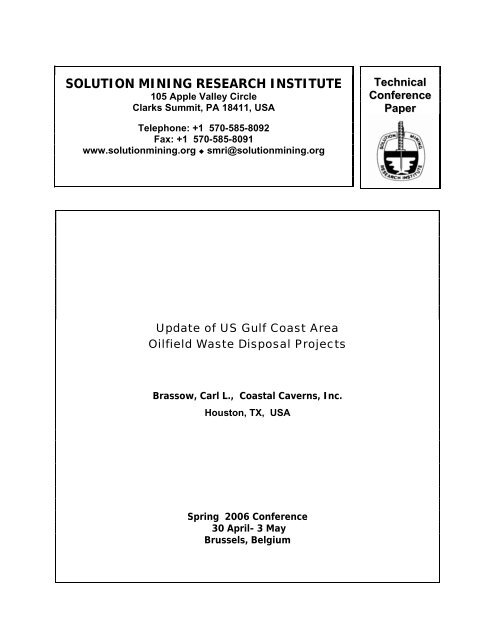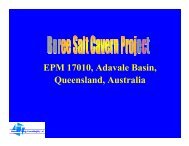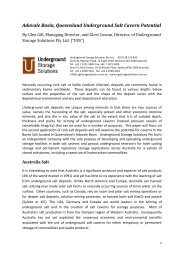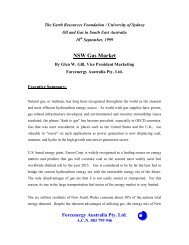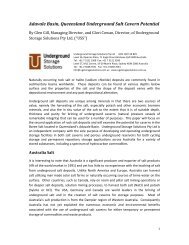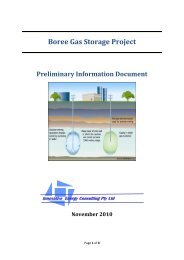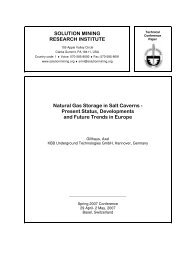Gulf Coast Waste Disposal in Salt Caverns
Gulf Coast Waste Disposal in Salt Caverns
Gulf Coast Waste Disposal in Salt Caverns
You also want an ePaper? Increase the reach of your titles
YUMPU automatically turns print PDFs into web optimized ePapers that Google loves.
SOLUTION MINING RESEARCH INSTITUTE105 Apple Valley CircleClarks Summit, PA 18411, USATechnicalConferencePaperTelephone: +1 570-585-8092Fax: +1 570-585-8091www.solutionm<strong>in</strong><strong>in</strong>g.org smri@solutionm<strong>in</strong><strong>in</strong>g.orgUpdate of US <strong>Gulf</strong> <strong>Coast</strong> AreaOilfield <strong>Waste</strong> <strong>Disposal</strong> ProjectsBrassow, Carl L., <strong>Coast</strong>al <strong>Caverns</strong>, Inc.Houston, TX, USASpr<strong>in</strong>g 2006 Conference30 April- 3 MayBrussels, Belgium
UPDATE OF US GULF COAST AREA OILFIELD WASTE DISPOSALPROJECTSCarl L BrassowPresident<strong>Coast</strong>al <strong>Caverns</strong>, Inc.1111 Bagby, Suite 4900Houston, Texas 77002AbstractInitial attempts to permit and construct salt caverns for the management of waste residuesbegan <strong>in</strong> the early 1980’s. For a variety of regulatory and political reasons, these earlyefforts were not successful. In the late 1980’s and early 1990’s, salt caverns wereproposed for the management of non-hazardous oilfield waste streams (E&P wastes).Several projects have been permitted s<strong>in</strong>ce that time and are currently operational andother projects are now <strong>in</strong> the permitt<strong>in</strong>g cycle. This paper gives a brief historicaloverview of several projects and discusses design and operational considerations ofseveral project either <strong>in</strong> operation or have permits pend<strong>in</strong>g before regulatory authorities.An overview and summary of lessons learned is provided and suggested areas of futureresearch are discussed.Key words: Environmental Protection and Regulatory Affairs; <strong>Waste</strong> <strong>Disposal</strong>; Oil andGas Drill<strong>in</strong>g <strong>Waste</strong>s; Cavern Design; Cavern Operation; Texas Regulations; LouisianaRegulations; International Regulations; <strong>Gulf</strong> <strong>Coast</strong> of the US and MexicoIntroductionEver <strong>in</strong>creas<strong>in</strong>g energy demands on a worldwide basis has significantly <strong>in</strong>creased drill<strong>in</strong>gand exploration activity. Virtually every country and cont<strong>in</strong>ent that has the potential foroil and gas deposits or has proven exploitable reserves is experienc<strong>in</strong>g drill<strong>in</strong>g andproduction activity result<strong>in</strong>g <strong>in</strong> large volumes of “oilfield wastes” which is comprisedprimarily of formation fluids, manufactured drill<strong>in</strong>g fluids, formation cutt<strong>in</strong>gs and tracesof oil or condensates. Countries that have regulatory programs <strong>in</strong> place for themanagement of these wastes streams classify and regulate these wastes <strong>in</strong> variousmanners. Both Europe, the UK and Mexico classify oilfield wastes as hazardous wastes(not toxic wastes) but the US classifies the fluids and cutt<strong>in</strong>gs produced from drill<strong>in</strong>g asan exempted waste from regulation under the Resource Conservation and Recovery Act(RCRA) as amended. This does not mean that there are no regulations <strong>in</strong> regards tooilfield wastes, only that the primary federal regulatory program does not impact drill<strong>in</strong>gwastes per se. The drill<strong>in</strong>g wastes are considered to be non-hazardous which provides the<strong>in</strong>dustry <strong>in</strong> the US with considerable options <strong>in</strong> determ<strong>in</strong><strong>in</strong>g how the wastes will bemanaged.
The <strong>Gulf</strong> of Mexico is heavily explored for oil and gas both by US companies <strong>in</strong> USwaters and also by Mexico through their state owned oil company PEMEX... Estimates ofvolumes produced off-shore Louisiana range from 10 to 15 million barrels annuallywhereas Texas volumes are lower, but still several million barrels. Estimates of Mexicanvolumes are thought to be similar to Texas. None the less both the US and Mexico (thegulf coast area) have str<strong>in</strong>gent management requirements <strong>in</strong> place for oilfield wastes andare gett<strong>in</strong>g stricter with time. To off set the “regulatory” costs of management, the<strong>in</strong>dustry has spent and cont<strong>in</strong>ues to spend time and resources on technology that canreduce costs, address specific regulatory requirements, handle large volumes and arerelatively simple to implement and or operate.Incentives for <strong>Salt</strong> Cavern <strong>Disposal</strong>The evolution of the use of salt formations has spanned several thousands of years.Evidence has been presented previously that an early form of br<strong>in</strong>e m<strong>in</strong><strong>in</strong>g occurred <strong>in</strong>Ch<strong>in</strong>a over three thousand years ago. Hard rock m<strong>in</strong><strong>in</strong>g of salt is well over a thousandyears old (Poland). More modern methods of br<strong>in</strong>e m<strong>in</strong><strong>in</strong>g were developed andimplemented <strong>in</strong> the early 1900s and the first serious use for hydrocarbon storage wasdeveloped <strong>in</strong> the mid-1900s. Thus we have progressed from food uses to conta<strong>in</strong>ment ofliquids and gases to now the isolation of certa<strong>in</strong> products from the biosphere for geologictime periods.One of the primary benefits of cavern disposal is that the process of receipt and <strong>in</strong>jectionis very cost effective. Off-shore and near shore generated wastes are usually transportedto a shore location for offload<strong>in</strong>g <strong>in</strong> relatively small steel conta<strong>in</strong>ers called cutt<strong>in</strong>g boxes(US) or skips (UK). This transport occurs as part of the normal logistical support of adrill<strong>in</strong>g rig. The off-load<strong>in</strong>g occurs at a transfer station (which is under the control of thewaste disposer) where the waste is aggregated <strong>in</strong>to a large barge for subsequent shipmentto the disposal site. This portion of the process is the same regardless of the f<strong>in</strong>al disposaltechnique. The difference at this po<strong>in</strong>t is that large volume vacuum or end dump trucksare loaded from the barge and driven to the cavern site where the waste is discharged <strong>in</strong>toa large concrete receiv<strong>in</strong>g bas<strong>in</strong> for resuspension of the solids and pumped directly <strong>in</strong>tothe cavern via a short pipel<strong>in</strong>e from bas<strong>in</strong> to wellhead. This does not require a segregationof different material types, a restriction on concentration of various constituents with<strong>in</strong>the wastes, such as free oil or chloride concentrations, or further siz<strong>in</strong>g by crush<strong>in</strong>g orgr<strong>in</strong>d<strong>in</strong>g of the product. The lack of rehandl<strong>in</strong>g or segregation allows for the most costeffective method on a per barrel or per ton basis than any other treatment or disposaltechnology.Another <strong>in</strong>centive for cavern disposal is that at the end of the fill<strong>in</strong>g period of a cavern orgroup of caverns, the well can be plugged and abandoned <strong>in</strong> such a manner so that thewaste streams are completely isolated from the surface and shallow subsurfaceenvironment. In contrast to this, shallow landfills or land farms conta<strong>in</strong> the product at ornear the surface which are <strong>in</strong> turn exposed to natural forces of w<strong>in</strong>d, ra<strong>in</strong> and othernatural events. Product <strong>in</strong>jected <strong>in</strong>to more conventional wells (porous media), althoughgenerally highly secure, are still subject to migration with<strong>in</strong> the receiv<strong>in</strong>g formation.
In addition to isolation from the surface environment, the product is prevented from anypost closure movement with<strong>in</strong> the salt formation. Although movement with<strong>in</strong> mostporous media may be considered small or <strong>in</strong>significant, movement of fluids conta<strong>in</strong><strong>in</strong>ghigh solids contents may be considerable <strong>in</strong> caprock or other under-pressured formations.This movement may be such that the product could move out of the zone under thecontrol of the operator result<strong>in</strong>g <strong>in</strong> non-compliance of permit conditions or potential legalaction from adjacent property owners.Exist<strong>in</strong>g and Proposed <strong>Gulf</strong> <strong>Coast</strong> ProjectsThe gulf coast area for the purposes of this paper extends from the Yucatan Pen<strong>in</strong>sula <strong>in</strong>Mexico to the western coastl<strong>in</strong>e of the state of Florida <strong>in</strong> the US. The exist<strong>in</strong>g andproposed projects discussed here<strong>in</strong> are all <strong>in</strong> the United States. Mexico will be discussedlater <strong>in</strong> the paper.The one exist<strong>in</strong>g and operational project discussed here<strong>in</strong> is located <strong>in</strong> the state of Texasapproximately mid-way between Houston and Beaumont, Texas. See Figure 1The cavern that is located on the site was orig<strong>in</strong>ally developed as a br<strong>in</strong>e well to supplysaturated br<strong>in</strong>e to a sulfur m<strong>in</strong><strong>in</strong>g operation as part of the Frasch Process used <strong>in</strong> them<strong>in</strong><strong>in</strong>g. The cavern was <strong>in</strong>itially drilled <strong>in</strong> 1968 and was m<strong>in</strong>ed for over 10 years. Thereis no <strong>in</strong>formation available on the circulation rates dur<strong>in</strong>g this time period s<strong>in</strong>ce the m<strong>in</strong>ewas closed down and dismantled <strong>in</strong> the 1980s time period and the records have not beenreta<strong>in</strong>ed. The cavern was re-entered with a new well and sonared to determ<strong>in</strong>e itsvolumetric capacity. The sonar <strong>in</strong>dicated a volume of 6.2 million standard barrels. Thecavern size and shape is shown on Figure 2.
The height of the cavern is approximately 800 feet and has a diameter of approximately350 feet. The top of the roof is 1410 feet below ground surface (bgs).Surface receiv<strong>in</strong>g facilities consist of a covered concrete truck receiv<strong>in</strong>g slab and washout area, a concrete receiv<strong>in</strong>g bas<strong>in</strong> with concrete approach ramps, an office and testlaboratory, equipment storage areas, steel waste transfer l<strong>in</strong>e to wellhead and some br<strong>in</strong>estorage tanks. The common driveway, park<strong>in</strong>g and facility grounds are built up to divertrun on of ra<strong>in</strong>fall and graded to control the location and direction of ra<strong>in</strong>fall run off. Thedesign philosophy was to m<strong>in</strong>imize external environmental impact and control to theextent possible on site events.The site is located about 25 miles from the closest available dock capable of manag<strong>in</strong>gthe large hopper barges used to transport the waste from the <strong>in</strong>itial receiv<strong>in</strong>g transferstations to the disposal site. This distance requires that the waste be off-loaded from thebarge, placed <strong>in</strong> trucks and transported to the site. The trucks are off-loaded <strong>in</strong>to thereceiv<strong>in</strong>g bas<strong>in</strong> where br<strong>in</strong>e is added as may be necessary to resuspend the solids found <strong>in</strong>the waste stream. Because of the potential volume of truck traffic, the receiv<strong>in</strong>g facilitieswere placed close to the public access road (about 2600 feet from the cavern wellhead)which then required the <strong>in</strong>stallation of the transfer pipel<strong>in</strong>e.
The key components of the receiv<strong>in</strong>g facility are the covered concrete truck receiv<strong>in</strong>gslab and the concrete bas<strong>in</strong>. The slab provides fro protected unload<strong>in</strong>g of liquid fill trucksand for wash out of all trucks after unload<strong>in</strong>g. The bas<strong>in</strong> is primarily below ground sothat end dump trucks with solids can unload and be mixed with br<strong>in</strong>e. This suspension ofmaterial is pumped up <strong>in</strong>to the centrifugal transfer pumps us<strong>in</strong>g submersible pumps andthen transferred to the disposal cavern. Figure 3 illustrates the surface facility layout.FIGURE 3The new re-entry well <strong>in</strong>to the cavern was designed to accommodate high volumes ofwastes. The cavern was permitted to receive up 15,000 barrels per day on a 24 hour basis(437 gpm or 1.6 m3/m<strong>in</strong>). Instantaneous rates higher than these levels are common due to
the addition of br<strong>in</strong>e to the raw waste received. Injection pressures of less than 300 psigare normal recorded at the transfer pumps. Pressures at the wellhead are less... To achievethese rates the <strong>in</strong>jection tube was sized at 5 ½ <strong>in</strong>ch OD which is suspended <strong>in</strong>side a 8 5/8<strong>in</strong>ch tube which <strong>in</strong> turn <strong>in</strong> suspended with<strong>in</strong> the last cemented str<strong>in</strong>g which is 10 ¾ <strong>in</strong>ch.Figure 4 is attached which illustrates the as built configuration of this cavern.Beaumont Area Cavern. Based on both the technical and commercial success of thisfirst disposal cavern, another cavern was located <strong>in</strong> the Beaumont, Texas area which wasjudged to be suitable for waste disposal. Lessons learned from the operations of the MossBluff were used <strong>in</strong> the evaluation of the site <strong>in</strong> Beaumont. Factors that were considered<strong>in</strong>cluded proximity to deep water barge access, truck<strong>in</strong>g distance to the disposal cavern,design of receiv<strong>in</strong>g facilities and cas<strong>in</strong>g/tub<strong>in</strong>g configuration.Experience at the Moss Bluff facility demonstrated the cas<strong>in</strong>g /tub<strong>in</strong>g configuration atthat facility was more than adequate to manage rout<strong>in</strong>e and greater than normal flowrates. Thus a cas<strong>in</strong>g /tub<strong>in</strong>g configuration similar to or even slightly smaller would besatisfactory. More important to the sit<strong>in</strong>g question was the proximity to deep water and am<strong>in</strong>imal truck haul distance if any. Both of these latter conditions have been satisfiedwith respect to the Beaumont site. Deep water access is with<strong>in</strong> 2 miles of the disposalcavern which provides for essentially un<strong>in</strong>terrupted barge movements to the dock and adem<strong>in</strong>imis truck<strong>in</strong>g distance.
The last significant factor at the Beaumont site was the surface receiv<strong>in</strong>g facilities fromthe standpo<strong>in</strong>t of whether worthwhile modifications could be made to the design and/or<strong>in</strong>stallation. A review of the <strong>in</strong>itial Moss Bluff receiv<strong>in</strong>g facility <strong>in</strong>dicated areas ofimprovement for efficiency purposes (functionally the orig<strong>in</strong>al design was more thanadequate). These areas of improvement <strong>in</strong>cluded <strong>in</strong>creased ramp area to allow moretrucks to unload simultaneously from three sides <strong>in</strong>stead of one side, a below surfacepump gallery to provide a cont<strong>in</strong>uous submerged suction to the transfer pumps thuselim<strong>in</strong>at<strong>in</strong>g an <strong>in</strong>termediate submersible pump to lift the waste to the transfer pumps,higher volume “gun” l<strong>in</strong>es to provide additional br<strong>in</strong>e to the waste to reduce viscosity andaugment resuspension of solids and reposition<strong>in</strong>g of tanks and other equipment tostreaml<strong>in</strong>e operations.Although the distance of transfer from the receiv<strong>in</strong>g bas<strong>in</strong> to the cavern wellhead at theMoss Bluff facility is 2600 feet and has caused no operational issues, it was felt thatreduc<strong>in</strong>g any transfer distance would be beneficial from a power consumption standpo<strong>in</strong>t.The receiv<strong>in</strong>g bas<strong>in</strong> is anticipated to be with<strong>in</strong> a 100 foot radius of the disposal cavernwellhead when construction is completed. Figure 5 is attached illustrat<strong>in</strong>g the generalsite layout of the surface facilities.
Louisiana Area Cavern. Ideally the most efficient site would be a site whereby a barge(or other vessel) could come to a receiv<strong>in</strong>g facility and unload directly to the disposalcavern. The Beaumont facility comes close to achiev<strong>in</strong>g the “ideal” location <strong>in</strong> as muchas the cavern is close to the barge receiv<strong>in</strong>g dock. The Louisiana location from atechnical standpo<strong>in</strong>t meets almost all of the technical/operational requirements of an idealsite because of proximity to the disposal cavern, lack of rehandl<strong>in</strong>g, and/or other wastecondition<strong>in</strong>g requirements. This site is located with<strong>in</strong> the saltwater marsh environment ofthe southern portion of the state of Louisiana. These southern saltwater marshes havebeen and are still heavily explored for oil and gas resources. The exploration sites aregenerally accessed by means of canals dredged to the site. The disposal site is located <strong>in</strong>an area of exist<strong>in</strong>g large bayous and <strong>in</strong>terconnect<strong>in</strong>g dredged canals which provides directaccess for the waste transport barges.This site overlies the entire domal salt formation. Similar to the other two Texas sites,this dome has two exist<strong>in</strong>g caverns developed as br<strong>in</strong>e wells <strong>in</strong> the 1960s and 1970s. Thewells were plugged and abandoned per regulatory requirements and thus, no sonar survey<strong>in</strong>formation is available. Based on some drill<strong>in</strong>g records, it estimated that several millionbarrels of capacity exists between the two caverns. New reentry wells will be drilled toaccess the caverns (after necessary operat<strong>in</strong>g permits have been obta<strong>in</strong>ed) us<strong>in</strong>gessentially the same cas<strong>in</strong>g/ tub<strong>in</strong>g design previously used. See Figure 6 for generallocation illustration.
S<strong>in</strong>ce the location is <strong>in</strong> a marsh area with little dry ground for receiv<strong>in</strong>g bas<strong>in</strong>s andassociated equipment, it was proposed to adopt and modify the relatively new method ofFloat<strong>in</strong>g Production and Storage vessels (FPSOs) used by the oil and gas produc<strong>in</strong>g<strong>in</strong>dustry as a self conta<strong>in</strong>ed receiv<strong>in</strong>g facility. Under this proposal, a large hopper or deckbarge would be configured to have br<strong>in</strong>e hold<strong>in</strong>g tanks, waste hold<strong>in</strong>g tanks, pumpgallery and pumps, necessary pipe runs and connections, power generation equipmentand some equipment storage. The deck would be designed to support a low pressure longstick crane <strong>in</strong> the event barges require solids removal not capable by pump<strong>in</strong>g. Personnelquarters would be available on a much smaller separate barge. This approach has severaladvantages given the character of the site <strong>in</strong> that on site construction activity ism<strong>in</strong>imized, extensive disturbance of the marsh environment is virtually elim<strong>in</strong>ated, andthe equipment can be removed by refloat<strong>in</strong>g the barge <strong>in</strong> the event of large hurricanessuch as was experienced last year <strong>in</strong> this general vic<strong>in</strong>ity. I should be noted that anecdotalevidence after the storm <strong>in</strong>dicates that such a facility as described above would have beenrelatively unaffected by the storm. See Figure 7 for a schematic illustration of theproposed receiv<strong>in</strong>g barge.
International PotentialAs mentioned previously, the gulf coast can be considered to encompass the zone fromthe Yucatan Pen<strong>in</strong>sula <strong>in</strong> Mexico to the Florida coast. Most of the coastl<strong>in</strong>e is <strong>in</strong> the USwith the majority if it shared between Texas and Louisiana. The nature of the <strong>Gulf</strong> ofMexico (GOM) exploration and production mandates that the bulk of the waste comeashore <strong>in</strong> these two states and be managed with<strong>in</strong> the states. Both states have specificregulatory programs and requirements for salt cavern disposal. See attachments 1 and 2for copies of the Texas and Louisiana regulations.<strong>Salt</strong> cavern disposal options are by no means restricted to the United States. There isevery reason to expect examples of cavern usage for disposal even though there may beno formal regulatory program. Other jurisdictions do <strong>in</strong> fact have formal regulatoryprograms <strong>in</strong> place. Mexico, for <strong>in</strong>stance, has a new formal regulation for the disposal of<strong>in</strong>dustrial wastes <strong>in</strong> caverns. Mexico does not exempt oil and gas wastes from theirhazardous waste regulations although they do allow for the <strong>in</strong>jection of oilfield wastes<strong>in</strong>to a br<strong>in</strong>e filled cavern. All other more traditional <strong>in</strong>dustrial sources (i.e. petrochemicalplants, ref<strong>in</strong>eries etc) must be treated or immobilized and then placed <strong>in</strong>to a dewateredcavern for ultimate disposal. See attachment 3 for a copy of the new Mexican regulation(Spanish version, English not available).Mexico would appear to be a natural place to site a disposal facility. The country has anabundance of salt both near the coast Veracruz area) and <strong>in</strong> the <strong>in</strong>terior (Monterey area).
The coastal salt domes are widely dispersed offer<strong>in</strong>g more than a s<strong>in</strong>gle possible location.The <strong>in</strong>terior deposits may be more suitable for <strong>in</strong>dustrial wastes.Outside of the <strong>Gulf</strong> of Mexico region, the next oil and gas produc<strong>in</strong>g region that wouldseem to offer serious potential would be the North Sea region. The countries with thehighest potential would first be the UK, then the Netherlands and then Denmark. This isbased on the fact that these countries conta<strong>in</strong> exploitable salt deposits and are proximateto oil and gas exploration activities <strong>in</strong> the North Sea. It does not mean that any of thesecountries have regulatory programs <strong>in</strong> place to provide for a project to be developed oreven have policies that would encourage the development of a project. Based on somelimited experience <strong>in</strong> the UK, it is known that the more recent EU Directives for wasteare favorable for salt cavern disposal. As the case <strong>in</strong> Mexico, oil and gas wastes are likelyto be classified as hazardous waste. A recent project <strong>in</strong> the Manchester region of the UKwas granted authority to dispose of treated/solidified wastes <strong>in</strong> a dry m<strong>in</strong>e. Seeattachment 4 for reference to the EU Directives.SummaryThe purpose of this paper was to provide a brief update on salt cavern waste disposalprojects (oilfield wastes) that are either <strong>in</strong> operation or proposed for development. Anadditional purpose was to outl<strong>in</strong>e changes made from one project to the next thatsignificantly improved operat<strong>in</strong>g efficiencies or cost effectiveness or both.The orig<strong>in</strong>al gulf coast high volume cavern was the Moss Bluff facility located betweenHouston and Beaumont. It is permitted to manage up 15,000 barrels per day of oilfieldwaste either as fluids, solids or <strong>in</strong> comb<strong>in</strong>ation. The depth to the top of cavern is 1400+feet bgs and had an <strong>in</strong>itial sonared volume of 6.2 million barrels. The last cemented str<strong>in</strong>gis 10 ¾ <strong>in</strong>ches and has two hang<strong>in</strong>g str<strong>in</strong>gs of 8 5/8 and 5 ½ <strong>in</strong>ches respectively. The siteis located <strong>in</strong>land about 26 miles from the receiv<strong>in</strong>g dock. Discharge is <strong>in</strong>to a 1500 barrelconcrete bas<strong>in</strong> us<strong>in</strong>g a submersible pump to transfer waste to the waste conveyance l<strong>in</strong>eand <strong>in</strong>to the cavern.The second proposed cavern is located <strong>in</strong> the Beaumont area which is closer to themajority of transfer locations which are the orig<strong>in</strong>al aggregators of the waste from thedrill<strong>in</strong>g rigs. The site is with<strong>in</strong> 2 miles of a deep water receiv<strong>in</strong>g dock which providesun<strong>in</strong>terrupted access for barges. The cavern is estimated to have similar or greatervolumes than the Moss Bluff caver with the cavern roof over 2200 feet bgs. S<strong>in</strong>ce wastedensities are greater than the br<strong>in</strong>e <strong>in</strong> the cavern, greater depths to the roof do not have alarge impact on pump<strong>in</strong>g costs. The receiv<strong>in</strong>g bas<strong>in</strong> will be concrete but smaller <strong>in</strong>volume and will have an underground pump gallery to provide for a cont<strong>in</strong>uoussubmerged suction for the transfer pumps. The bas<strong>in</strong> will be only a short distance fromthe cavern wellhead <strong>in</strong> order to reduce transfer distances and l<strong>in</strong>e losses.F<strong>in</strong>ally, the second proposed project is <strong>in</strong> Louisiana which is <strong>in</strong> the midst of the majorityof transfer stations that aggregate the wastes thus reduc<strong>in</strong>g primary barge transferdistances. The facility is located over a salt dome with the receiv<strong>in</strong>g facility be<strong>in</strong>g a
econfigured barge that is self conta<strong>in</strong>ed. All equipment and process takes place on thevessel and then the waste is pumped directly to the cavern. The caverns are estimated tobe several millions of barrels <strong>in</strong> capacity with cavern roofs comparable to the Beaumontarea cavern. Cas<strong>in</strong>g/tub<strong>in</strong>g configurations are similar to the other caverns describedThe <strong>Gulf</strong> of Mexico is not the only area that can be developed for oilfield wastes.Projects are possible <strong>in</strong> Mexico and at other <strong>in</strong>ternational locations <strong>in</strong>clud<strong>in</strong>g but notlimited to selected EU countries.
ATTACHMENTS Available on the conference CD or from the <strong>in</strong>ternetATTACHMENT 1Texas Railroad Commission Rule 8 and Rule 9ATTACHMENT 2Louisiana Rule 29- M -2Title 43 NATURAL RESOURCES Part XVII. Office of ConservationInjection and M<strong>in</strong><strong>in</strong>g Subpart 4. Statewide Order No. 29-M-2Chapter 31. <strong>Disposal</strong> of Exploration and Production <strong>Waste</strong> <strong>in</strong> Solution-M<strong>in</strong>ed <strong>Salt</strong> <strong>Caverns</strong>§3101. Def<strong>in</strong>itions(no attachment 3)ATTACHMENT 4Mexico Rules for <strong>Salt</strong> Cavern <strong>Disposal</strong> (Spanish Version)NORMA Oficial Mexicana NOM-145-SEMARNAT-2003, Conf<strong>in</strong>amiento de residuos en cavidades construidaspor disolución en domos sal<strong>in</strong>os geológicamente estables.Al margen un sello con el Escudo Nacional, que dice: Estados Unidos Mexicanos.- Secretaría de MedioAmbiente y Recursos Naturales.


